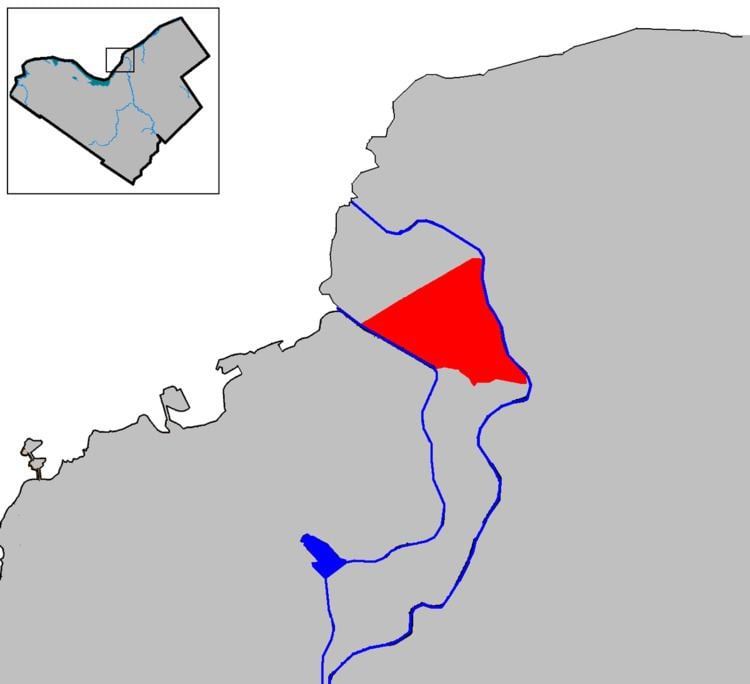Country Canada Time zone Eastern (EST) (UTC-5) Population 12,490 (2011) Local time Tuesday 9:00 AM | Elevation 70 m | |
 | ||
Weather 2°C, Wind W at 6 km/h, 86% Humidity Restaurants Laurier Social House, Café Nostalgica, Father & Sons Restaurant, Perfection Satisfaction Promise, Pizza Lovers Hotels Auberge McGee's Inn, Premiere Suites Ottawa R, Alexander House Bed & Breakfast, University of Ottawa Student R, Olde Bytown Bed & Br | ||
Sandy Hill (French: Côte-de-Sable) is a neighbourhood in Ottawa, Ontario, located just east of downtown. The neighbourhood is bordered on the west by the Rideau Canal and on the east by the Rideau River. To the north it stretches to Rideau Street and the Byward Market area while to the south it is bordered by the Queensway highway and Nicholas Street. The area is named for its hilliness, caused by the river, and its sandy soil, which makes it difficult to erect large buildings. It is home to a number of embassies, residences and parks. Le cordon bleu operates its Canadian school there, at the opposite end of Sandy Hill from the University of Ottawa.
Contents
- Map of Sandy Hill Ottawa ON Canada
- 37a robinson ave sandy hill ottawa video tour
- History
- Geography
- Notable sites
- Notable residents
- Embassies
- Churches
- References
Map of Sandy Hill, Ottawa, ON, Canada
According to the Canada 2011 Census, the population of Sandy Hill was 12,490.
37a robinson ave sandy hill ottawa video tour
History
Sandy Hill was, during the nineteenth and early twentieth century, Ottawa's wealthiest neighbourhood. Originally the estate of Louis-Théodore Besserer, who donated part of this land to University of Ottawa, it was subdivided and became home to most of Ottawa's lumber barons. When Ottawa became the country's capital, it became home to senior public servants and to the Prime Minister who lived at Stadacona Hall and later at what is now known as Laurier House.
The construction of bridges over the canal and the introduction of automobiles and streetcars made the area much more accessible to downtown, and it began to decline as the very wealthy moved to Rockcliffe Park. The neighbourhood became much denser and more middle class. It was predominantly francophone, and the 1960s Radio-Canada television network drama "La Côte de Sable" was set there, to this day one of the network's only drama set outside Quebec.
The area saw much growth at the end of the Second World War as the baby boom increased the population and the nearby federal government began hiring. Many of the once grand mansions became embassies. Many nations still have their embassies in Sandy Hill, including those of Russia and of many African nations, which are clustered near the Rideau River. Its population dropped by 30% in the '60s and '70s as families fled the dismal urban planning. Currently, there are many students living in the area due to its proximity to the University of Ottawa.
Geography
Unusual among modern urban neighbourhoods, Sandy Hill demographics change dramatically within a few blocks. Very wealthy people live near the embassies of the Rideau River, but closer to the university, one finds more students, senior citizens, and new immigrants with more diversified income levels. Housing in the western end of Sandy Hill includes boarding houses, student rental housing, modest privately owned homes and cooperative housing. For example, on Henderson Avenue, a historically Irish working-class sector of Sandy Hill, there are two Housing Cooperatives: Sandy Hill Housing Co-op and St. Georges Housing Cooperative / la Coopérative d'habitation St Georges, a bilingual, multicultural coop, with residents who come from Canada, with neighbours newly arrived from Ghana, DR Congo, Morocco, Rwanda, Burundi, Poland and several Middle Eastern countries. These Coops not only provided attractive low-rise multi-housing mixed income communities but also contributed to the restoration of the heritage homes on this street and won awards for their contribution to Sandy Hill's heritage restoration.
The Sandy Hill area is split about equally between the English speaking and the francophone population, with large communities from Somalia, Lebanon, and Haiti. The area is very close to downtown, especially to the Rideau Centre, a large downtown shopping mall. The area is well served by mass transit and the transitway passes by the university.
Sandy Hill is often divided into four areas. North Sandy Hill consists of the area north of Laurier Avenue. This part of the neighbourhood is much older with many of its buildings dating from the nineteenth century. The area is subject to the influences of more recent developments on the thoroughfare of Rideau Street. South of Laurier is South Sandy Hill largely built after the Second World War, though there are a number of much older structures. The far south of neighbourhood below Mann Avenue is an area known as Strathcona Heights. This area is much smaller geographically than the other two but is as densely populated. It consists almost entirely of low-rise apartment buildings that are either subsidised housing or co-operatives. This area was completely redeveloped in the early 1990s. The area below the Strathcona Heights escarpment, near the Rideau River, is known as Robinson village. It was cut off from other neighbourhoods when highways were built, and contains low-rise houses and light industrial uses.
Notable sites
Notable residents
By virtue of its proximity to Parliament Hill, many past residents of Sandy Hill have been politicians.
Embassies
The large homes built by the lumber barons are today popular locations for embassies and many countries are represented in the neighbourhood:
